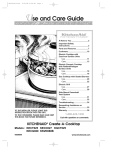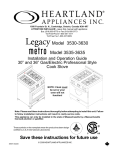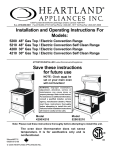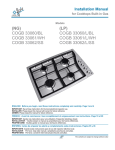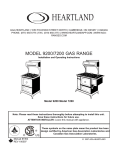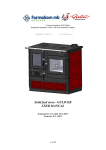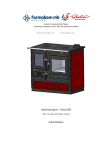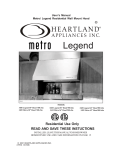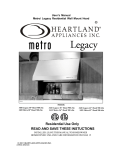Download Heartland Bakeware 3805-3825 User's Manual
Transcript
1050 Fountain St. N., Cambridge, Ontario, Canada N3H 4R7 Bus. (519) 650-5775 or Fax (519) 650-3773 Toll Free Phone 1-800-361-1517 Toll Free Fax 1-800-327-5609 Model 3800-3820 Model 3805-3825 Installation and Operation Guide 30” and 36” Gas Cooktop 36” cooktop 30” cooktop Note: Please read these instructions thoroughly before attempting to install this unit. Failure to follow installation instructions will result in costly service calls. Note: This appliance can only be installed in the state of Massachusetts by a Massachusetts licensed plumber or gasfitter. ® CERTIFIED C US Save these instructions for future use © 2005 HEARTLAND APPLIANCES INC. 032205 #39380 ATTENTION INSTALLER: Leave this manual with appliance Gas Cooktop Models 3800/3820 Legacy and 3805/3825 Metro CONSUMER WARRANTY FIRST YEAR HEARTLAND warrants the replacement or repair of all parts, including gas components of this Cooktop which prove to be defective in material or workmanship, with the exception of the painted or porcelain enamel finish and plated or stainless steel surfaces, for one year from the date of original purchase. Such parts will be repaired or replaced at the option of Heartland without charge, subject to the terms and conditions set out below. The warranty period against defects in the painted or porcelain enamel finish and plated or stainless steel surfaces, is 90 days from date of original purchase. TERMS AND CONDITIONS 1. This warranty applies only for single family domestic use when the Cooktop has been properly installed according to the instructions supplied by Heartland and is connected to an adequate and proper utility service. Damage due to faulty installation, improper usage and care, abuse, accident, fire, flood or other acts of God, commercial, business or rental use, and alteration, or the removal or defacing of the serial plate, cancels all obligations of this warranty. Service during this warranty must be performed by a factory Authorized Service Person. 2. Warranty applies to product only in the country in which it was purchased. 3. Heartland is not liable for any claims or damages resulting from any failure of the Cooktop or from service delays beyond their reasonable control. 4. To obtain warranty service, the original purchaser must present the original Bill of Sale, Model and Serial number. Components repaired or replaced are warranted through the remainder of the original warranty period only. 5. The warranty does not cover expense involved in making this appliance readily accessible for servicing, replacement of house fuses or fuse boxes, or resetting of circuit breakers. 6. This warranty gives you specific legal rights. Additional warranty rights may be provided by law in some areas. 7. Adjustments such as education of customer in proper use and care of product calibrations, air shutter adjustments, levelling, tightening of fasteners, or utility connections normally associated with original installation are the responsibility of the dealer or installer and not that of the Company. 8. Breakage, discoloration or damage to metal surfaces, plastic components, trim, paint, porcelain or other cosmetic finish, caused by improper usage or care, abuse, or neglect is not covered under this warranty. Fill in the spaces below for future reference, should service be required. PLACE OF PURCHASE______________________________ DATE OF PURCHASE_______________________________ SERIAL NUMBER__________________________________ MODEL NUMBER__________________________________ If further help is needed concerning this warranty, contact: Customer Service Heartland Appliances Inc. 1050 Fountain St. N., Cambridge, Ontario, Canada N3H 4R7 Bus. (519) 650-5501 or Fax (519) 650-3773 Toll Free Phone 1-800-361-1517 Toll Free Fax 1-800-327-5609 Table of Contents Metro / Legacy Cooktop Section 1: Installation & Assembly ............. 2 Preparing the Installation Site.......................... 2 Installation Clearances .................................... 2 Installation / Clearance Diagrams .............. 3-10 Exhaust Hood ................................................. 11 Electrical Installation ...................................... 11 Gas Line Installation ....................................... 11 Preparing the Cooktop for Installation .......... 12 Section 2: Cooking Controls ...................... 13 Cooktop Features........................................... 13 Control Panel Graphic ................................... 14 Section 3: Burner & Grill Operation ........ 15 Lighting the Top Burners and Grill ................ 15 Small Pot Ring / Trivet .................................. 15 Grilling Guide ................................................. 16 Section 4: Care & Cleaning .......................17 Porcelain – Legacy Series ............................ Stainless Steel – Metro Series ...................... Surface Burners ............................................ Nickel Plated Parts ....................................... Grill ................................................................ 17 17 18 18 19 Section 5: Trouble Shooting .......................20 Burner Set Up and Adjustment ..................... Power Failure Operation ............................... Gas Trouble Shooting .................................... Gas Trouble Shooting Chart .......................... 20 21 21 22 Section 6: Reference .................................. 23 Accessories .................................................... 23 Conversion Kits and Information ................... 23 Parts Drawing and Description ..................... 24 Section 7: Safety Guidelines ......................25 Important Safety Instructions ........................ 25 Exhaust Hood Safety .................................... 25 Selecting the Proper Cookware .................... 26 Safety Precautions ................................... 27-28 Warning: If the information in this manual is not followed exactly, a fire or explosion may result, causing property damage, personal injury, or death. Do not store or use gasoline or other flammable vapours and liquids in the vicinity of this or any other appliance. What to do if you smell gas • Do not try to light any appliance. • Do not touch any electrical switch. Do not use any telephone in your building. • Immediately call your gas supplier from your neighbour’s phone. Follow the gas supplier’s instructions. • If you can not reach your gas supplier, call the fire department. Installation and service must be performed by a qualified installer, service agency, or the gas supplier. The use of a gas cooking appliance results in the production of heat and moisture in the room in which it is installed. Ensure that the kitchen is well ventilated. Keep natural ventilation holes open or install a mechanical device (mechanical extractor hood). Prolonged intensive use of the appliance may call for additional ventilation. Open a window. For more effective ventilation, increase the level of mechanical ventilation. - FOR YOUR SAFETY Do not store or use gasoline or other flammable vapours or liquids in the vicinity of this appliance. • • • • • Do not use the cooktop as a heater. Do not heat unopened glass or metal containers. Grease accumulation is the cause of many cooking fires. Do not attempt to extinguish a grease fire with water. Cover grease fires with a pot lid or baking soda. Avoid the use of aerosol containers near the cooktop. Note: This unit contains a pre-set regulator. Installation and Assembly Safety Instructions Please check for any damage that may have occurred during shipping. In the unlikely event that you find any shipping damage, inform your dealer immediately! Legacy and Metro cooktops consist of the cooktop body and the backguard. Tools required for assembly: • Screwdriver Phillips/Robertson • Utility knife • Level You must have a qualified electrician connect the new range to be sure all electrical codes and regulations are observed except when range is equipped with a cord and plug. A qualified gas technician must install this appliance to ensure local installation codes and regulations are observed. Preparing the Installation Site Find the appropriate clearance/installation diagram for your cooktop on the following pages. Diagrams include installations with an exhaust hood. These diagrams will outline the required opening for your cooktop and clearances to cupboards, electrical outlets, and gas outlet locations are also illustrated. Site preparation can be made to have these utilities ready prior to receipt of the cooktop. Caution: To avoid mishaps during the installation phase, ensure power to receptacle and gas valve are off. Installation Clearances Should the cooktop be installed adjacent to a refrigerator, it is important that there be a minimum of 5” (13 cm) of space between the two appliances for proper air circulation. Installation of cabinet storage space above the surface burners should be avoided to eliminate the risk of burns or fire by reaching over the surface burners. Your cooktop should be level for best cooking results. To verify, place a carpenter’s level on top of the cooking surface. If leveling is required, shim under cooktop. See page 3 and 4 -for 30” Legacy See page 5 and 6 -for 36” Legacy See page 7 and 8 -for 30” Metro See page 9 and 10 -for 36” Metro 2 Installation Diagram- 30” Legacy Cooktop Model 3800 A C B D1 D 2 3 D Air intake slots on underside of control panel must not be obstructed or covered. Figure 1 Table 1 Dim 30" Legacy Cooktop A 26 5/8" (68cm) B 8 1/4" (21cm) C 29 3/4" (76 cm) D1 Standard profile: 14 1/4"(36 cm) (as shown in diagram) D2 low profile: 10 1/8" (26 cm) D3 high back w/ shelf: 28 1/4" (72cm) Clearances • Minimum distance between the cooktop and a side wall above the cooktop surface is 6” (see dim "J" in Table 2 on next page) • Depth of cutout must not exceed 25”. (see dimension G) Air intake slots on underside of control panel must not be obstructed or covered. Electrical requirements: • Electrical hookup must be done by a licenced electrician • 120 Volts 60Hz .375 kW 3 prong plug 5 ft-(1.5 m) power cord included. Gas Requirements: • Gas hook-up must be done by a licensed gas fitter. • Pressure requirements: Natural gas: 6” W.C. (min); LP gas: 11” W.C. (min) • Connection: 1/2” NPT • An accessible manual shut off valve must be installed at the appliance. • Note: This unit contains a pre-set regulator • Natural Gas/Propane Conversion kits are available - must be done by a licensed gas fitter 3 Clearance Diagram- 30” Legacy Cooktop Model 3800 An appropriate exhaust hood with a minimum of 450 CFM is required on all 30" Legacy cooktops to ensure adequate and proper ventilation. For superior ventilation we recommend using a 36” hood, however a 30” hood is adequate. L J G M H 1 K N N 2 I O Note: Support deck must be able to support a total weight of 4 burner model: 175 lbs Figure 2 Note: If cooktop must stand beside a refrigerator, it is important for proper air circulation that there be at least 5” (13 cm) of space between the two appliances. Table 2 Dim 30" Legacy Cooktop G Maximum 25" (63cm) H Maximum 7 3/4" (21cm) I 30" (77 cm) J Minimum 6" (15cm) left and right side K 13"(33cm) L Specify Width of Hood M 24" (61cm) N1 30" min to 36" max (76-92cm) for standard and high back guard N2 30" min to 32 "max (76-82cm) for low profile back guard O 18" (45cm) 4 Installation Diagram- 36” Legacy Cooktop Model 3820 C B Air intake slots on underside of control panel must not be obstructed or covered. Figure 1 Dim 36" Legacy Cooktop A 26 5/8" (68cm) B 8 1/4" (21cm) C 36" (91cm) D1 Standard profile: 14 1/4" (36cm) (as shown in diagram) D2 Table 1 low profile: 10 1/8" (26 cm) D3 high back w/ shelf: 28 1/4" (72cm) Clearances • Minimum distance between the cooktop and a side wall above the cooktop surface is 6” (see dim "J in Table 2 on next page) • 0” Clearance to the back of the cooktop may be obtained when installing the appliance against a non-combustible wall or with the installation of our Splashback Kit. Responsibility for ensuring that the rear wall is non-combustible lies with the owner or end user. (check local building codes) - if wall behind cooktop is deemed combustible and our splashback kit is not installed, then the minimum spacing from the back of stove to nearest combustible wall is 6” • Depth of cutout must not exceed 25”. (see dimension G) Air intake slots on underside of control panel must not be obstructed or covered. Electrical requirements: • Electrical hookup must be done by a licenced electrician • 120 Volts 60Hz .375 kW 3 prong plug 5 ft-(1.5 m) power cord included. Gas Requirements: • Gas hook-up must be done by a licensed gas fitter. • Pressure requirements: Natural gas: 6” W.C. (min); LP gas: 11” W.C. (min) • Connection: 1/2” NPT • An accessible manual shut off valve must be installed at the appliance. • Note: This unit contains a pre-set regulator. • Natural Gas/Propane Conversion kits are available - must be done by a licensed gas fitter 5 Clearance Diagram- 36” Legacy Cooktop Model 3820 An appropriate exhaust hood with a minimum of 900 CFM is required on all 36" Legacy cooktops to ensure adequate and proper ventilation. For superior ventilation we recommend using a 42” hood, however a 36” hood is adequate. L J G M H 1 N N K 2 I O Note: Support deck must be able to support a total weight of Grill model : 200 lbs 6 burner model: 220 lbs Figure 2 Note: If cooktop must stand beside a refrigerator, it is important for proper air circulation that there be at least 5” (13 cm) of space between the two appliances. Table 2 Dim 36" Legacy Cooktop G Maximum 25" (63cm) H Maximum 7 3/4" (21cm) I 36 1/4" (92cm) J Minimum 6" (15cm) left and right side K 13"(33cm) L Specify Width of Hood M 24" (61cm) N1 30" min to 36" max (76-92cm) for standard and high back guard N2 30" min to 32" max (76-82cm) for low profile back guard O 18" (45cm) 6 Installation Diagram- 30” Metro Cooktop Model 3805 A C D 1 B D 2 D 3 Air intake slots on underside of control panel must not be obstructed or covered. Figure 1 Dim 30" Metro Cooktop A 26 5/8" (68cm) B 8 1/4" (21cm) C 29 3/4" (76 cm) D1 Standard profile:12 3/4"(32 cm) (as shown in diagram) D2 low profile: 10 1/8" (26 cm) D3 high back w/ shelf: 28 1/4" (72cm) Table 1 Clearances • Minimum distance between the cooktop and a side wall above the cooktop surface is 6” (see dim "J" in Table 2 on next page) • Depth of cutout must not exceed 25”. (see dimension G) Air intake slots on underside of control panel must not be obstructed or covered. Electrical requirements: • Electrical hookup must be done by a licenced electrician • 120 Volts 60Hz .375 kW 3 prong plug 5 ft-(1.5 m) power cord included. Gas Requirements: • Gas hook-up must be done by a licensed gas fitter. • Pressure requirements: Natural gas: 6” W.C. (min); LP gas: 11” W.C. (min) • Connection: 1/2” NPT • An accessible manual shut off valve must be installed at the appliance. • Note: This unit contains a pre-set regulator. • Natural Gas/Propane Conversion kits are available - must be done by a licensed gas fitter 7 Clearance Diagram- 30” Metro Cooktop Model 3805 An appropriate exhaust hood with a minimum of 450 CFM is required on all 30"Metro cooktops to ensure adequate and proper ventilation. For superior ventilation we recommend using a 36” hood, however a 30” hood is adequate. L J G M H K N1 N2 I O Note: Support deck must be able to support a total weight of 4 burner model: 175 lbs Figure 2 Note: If cooktop must stand beside a refrigerator, it is important for proper air circulation that there be at least 5” (13 cm) of space between the two appliances. Table Dim 30" Metro Cooktop G Maximum 25" (63cm) H Maximum 7 3/4" (21cm) I 30" (77 cm) J Minimum 6" (15cm) left and right side K 13"(33cm) L Specify Width of Hood M 24" (61cm) N1 30" min to 36" max (76-92cm) for standard and high back guard N2 30" min to 32" max (76-82cm) for low profile back guard O 18" (45cm) 2 8 Installation Diagram- 36” Metro CooktopModel 3825 C B Air intake slots on underside of control panel must not be obstructed or covered. Figure 1 Dim 36" Metro Cooktop A 26 5/8" (68cm) B 8 1/4" (21cm) C 36" (91cm) D1 Standard profile:12 3/4" (32 cm) (as shown in diagram) D2 low profile: 10 1/8" (26 cm) D3 high back w/ shelf: 28 1/4" (72cm) Table 1 Clearances • Minimum distance between the cooktop and a side wall above the cooktop surface is 6” (see dim "J" in Table 2 on next page) • 0” Clearance to the back of the cooktop may be obtained when installing the appliance against a non - combustible wall or with the installation of our Splashback Kit. Responsibility for ensuring that the rear wall is non - combustible lies with the owner or end user. (check local building codes) - if wall behind cooktop is deemed combustible and our splashback kit is not installed, then the minimum spacing from the back of stove to nearest combustible wall is 6” • Depth of cutout must not exceed 25”. (see dimension G) Air intake slots on underside of control panel must not be obstructed or covered. Electrical requirements: • Electrical hookup must be done by a licenced electrician • 120 Volts 60Hz .375 kW 3 prong plug 5 ft-(1.5 m) power cord included. Gas Requirements: • Gas hook-up must be done by a licensed gas fitter. • Pressure requirements: Natural gas: 6” W.C. (min); LP gas: 11” W.C. (min) • Connection: 1/2” NPT • An accessible manual shut off valve must be installed at the appliance. • Note: This unit contains a pre-set regulator. • Natural Gas/Propane Conversion kits are available - must be done by a licensed gas fitter 9 Clearance Diagram- 36” Metro Cooktop Model 3825 An appropriate exhaust hood with a minimum of 900 CFM is required on all 36" Metro cooktops to ensure adequate and proper ventilation. For superior ventilation we recommend using a 42” hood, however a 36” hood is adequate. L J G M H 1 K N N 2 I O Note: Support deck must be able to support a total weight of Grill model : 200 lbs 6 burner model: 220 lbs Figure 2 Note: If cooktop must stand beside a refrigerator, it is important for proper air circulation that there be at least 5” (13 cm) of space between the two appliances. Dim 36" Metro Cooktop G Maximum 25" (63cm) H Maximum 7 3/4" (21cm) I 36 1/4" (92cm) J Minimum 6" (15cm) left and right side K 13"(33cm) L Specify Width of Hood M 24" (61cm) N1 30" min to 36" max (76-92cm) for standard and high back guard N2 30" min to 32" max (76-82cm) for low profile back guard O 18" (45cm) Table 2 10 Exhaust Hood An exhaust hood must be installed over your new appliance. (see fig. 2) Exhaust hoods to match the Legacy and Metro cooktops are available from your dealer. Our hoods are designed and built to complement your range’s visual appeal and performance. Should you wish to install an exhaust hood of your own choice, ensure that the exhaust hood you purchase is the correct size and capacity for your Heartland cooktop. Please follow the exhaust hood manufacturers installation instructions. When installing an after market exhaust hood over a Heartland cooktop we recommend that you use the clearances as shown in the clearance diagrams for exhaust hood installations. See page 3-10. Venting Safety Guidelines: Installation must be completed in accordance with all local and national codes. Use only materials which conform to local codes in effect. Be sure the power is disconnected before doing any electrical work. All duct work must be metal. Do not use plastic duct. The hood should never be exhausted into a wall cavity or an attic where an accumulation of grease could become a fire hazard. When the installation is completed, turn on the fan and make sure that there are no obstructions in the line. Electrical Installation Electrical requirements: standard 120 volts 60 Hz .375 Kw volt receptacle, properly polarized, on it’s own line. Cooktops are supplied with a 3 prong 5 ft. (1.5 m) moulded plug cap power cord. Models 3800/3820 and 3805/3825 gas cooktops must be electrically grounded in compliance with local codes. In the absence of local codes, the installation must conform with the National Electrical Code. Disconnect the electrical supply and turn off the gas supply before servicing the appliance. Gas Line Installation Gas requirements: 30” and 36” Heartland gas cooktop models can be operated with either natural gas or liquid propane (LP). The cooktops are set for either natural gas OR propane at the factory. A conversion kit may be purchased at a later time and installed on site should the need arise. The cooktop requires a ½” NPT connector. Use minimum 5/8” diameter flexible line. Note: This unit contains a pre-set regulator. The cooktop must be installed in compliance with local codes. In the absence of local requirements, the installation must conform with the National Gas Code. Note: Appliances installed in the state of Massachusetts: - This appliance can only be installed in the state of Massachusetts by a Massachusetts licensed plumber or gas fitter -This appliance must be installed with a three (3) foot / 36 inch long flexible gas connector -A “T” handle type manual gas valve must be installed in the gas supply line to this appliance During any pressure testing of the gas supply piping system, at test pressures equal to or less than 2.5 KPS, the cooktop must be isolated from the gas supply piping system by closing its individual manual shutoff valve. The maximum propane/natural gas supply inlet pressure must not exceed 14” of water column. The minimum gas supply inlet should be at least 6” of water column for natural gas or at least 11” of water column for LP gas. 11 Preparing the Cooktop for Installation 1. Carefully remove banding with metal shears. Caution: banding may be under pressure, wear gloves to protect hands from accidental cuts. 2. Remove cardboard lid. 3. On 30” models there are 2 individual boxed grates. Remove from packaging and inspect the grates for any damage to the finish. 36” models have 3 individual boxed grates. 36” grill models have 2 grates. 4. Remove remaining styrofoam packaging and the 4 corner pieces. Removing Cooktop from Packaging: (fig. 3) Cooktop Cut-out handles 5. With TWO people, carefuly lift the cooktop top from the box using the cardboard support with the cut-out handles for lifting. (See fig. 3) 6. Place cooktop on a solid table for removal of plastic bag and a final inspection of product. 7. Check each burner to ensure that during shipping the burner pieces have not become dislodged from their proper position. See page 20 for proper positioning. 8. Assemble the backguard. (See fig. 4) Locate the backguard at the back of the cooktop. Remove screws and backguard. Do not throw these screws away. They are required to reinstall the backguard. Line up holes in the backguard with the holes in the back of the cooktop. Cooktop Backguard Assemble (fig. 4) 9. If you are installing a 20” high profile backguard: a. Unpackage. b. Secure 20” high profile back to the stove top using: 3-large metal washers. 3-small metal washers. 3-stainless steel screws. c. Secure back panel to the 20” high profile back using: 9-black sheet metal screws.(do not secure t he three bottom holes at this time) d. Secure brackets (#3266-3 pcs.)to the 20” high profile back and stove top,using 6 black sheet metal screws. 12 Cooking Controls The cooking controls are located on the front of the cooktop. These controls offer an infinite number of heat settings for ease and accuracy in cooking. They have a range from 15,500 BTU (setting #5) to as low as 450 BTU (setting #1) Refer to page 14 (fig.6) or page 17 (fig.7) for details. Cooktop Features A. Burners feature 15,500 BTU (4.4kW) easy clean, sealed style, dual head burners. The outer head is designed for high temperature, heavy duty jobs. The inner head is more suited for low temperature requirements, such as sauces and melting chocolate. Output is adjustable to as low as 450 BTU. B. Gas burner controls allow for an infinite selection of cooking temperatures. Push and turn style controls are positioned at the front of the cooktop for easy access. All models feature “auto-reignition” Should the flame go out for any reason, the igniter automatically begins to spark to reignite the burner. C. Grill models feature two 7,500 BTU twin burners – for a total of 15,000 BTU. These are adjustable to as low as 1,000 BTU. Front and back grill burners can be separated independently from each other. Push and turn controls to light each burner. The grill also has the same “autoreignition” feature as the top burners. A C B Cooking Controls (fig 5) 13 Control Panel Graphic (fig 6) These illustrations show the control panel layout of each model. The Legacy is shown, however, the Metro has a similar layout. 4 burner - top illustration 6 burner - middle illustration 4 burner & grill - bottom illustration 14 Burner and Grill Operation Lighting the Top Burners and Grill Cooktop is equipped with a spark ignition system that is electrically operated. Pushing in and turning the knob to any position will light the burner. When the knob is turned, a distinct clicking noise will be heard. After the burner lights, the clicking noise will stop. Note: When lighting any one burner, all burners will spark, but only the burner selected will light. All models feature “autoreignition” – should the flame go out for any reason, the igniter automatically begins to spark to re-ignite the burner. See “Reference” section for manual lighting procedure. Propane Stoves: a slight pop or flash may occur at the burner ports for a few seconds after the burner has been turned off. This “extinction pop” is normal for propane gas. Small Pot Ring / Trivet Pot ring support is used when cooking on top burners while using a small pot. The trivet fits on any burner. Each channel fits on one of 4 fingers on the burner grate. (see fig 8 ) (fig 8) This channel fits on a finger on the burner grate. Note: Incorrect burner alignment will produce a potentially dangerous flame and poor burner performance. (refer to fig 11) Dials Grill - left dial Burner - right dial (fig 7) 15 Grilling Guide (For 36” units with grill feature) Generally we recommend preheating the grill 10 minutes on high. This provides a more even heating of the grill. Then follow the guide below. When grilling roasts and thick meats sear on high then reduce heat to allow food to cook throughout and not burn. Turn meats once after juices appear on the surface. Flare-ups will naturally occur when fat falls on the flame so do not leave unattended. Until flaming subsides reduce heat and use a long handled spatula or tongs to move meat to a different area of grill. Brush BBQ sauces on during last few minutes of grilling. Meat Beef Pork Lamb Cut Flame Size Thickness Approximate Cooking Time (in minutes) & Comments Steaks High Inches Cent. ¾-1 2 Ground beef patties Medium ¾ 2 Hot dogs Medium 8-15 total, turning once & cooking until well done 5-10, turning once Pork chops or kabobs Medium to sear each side; then low High ¾-1 2 ¾-1 2 5/side to sear; then 30-40 or until no longer pink 5-7 total, turning once Lamb chops or kabobs Chicken Chicken parts, with bone and skin Boneless, skinless breasts Whole or steaks Fish Boneless fillets Lobster tails, thawed Medium to brown; then low to finish Medium to brown; then low to finish Medium Until it flakes with fork ¾-1 2 5-7 total, turning once 5/side to brown; then 3040 until juices run clear 5/side to brown; then 1020 until no longer pink 8-10 total or until it flakes with fork 5-10 total 8-10 total 16 Care and Cleaning Porcelain – Legacy Series Stainless Steel – Metro Series Keeping it clean The porcelain is very serviceable and simple to clean, but because it is glass, it will not withstand rough handling or abuse. Never place a cold wet cloth on a hot porcelain surface. Porcelain is glass and sudden changes in temperature may cause cracking. To clean porcelain surfaces, use warm, soapy water, glass cleaner or non abrasive cleaner and a soft cloth. Avoid abrasive cleaners. If any acid based food or liquid, such as lemon juice or tomato juice, is spilled on the cooktop, wipe it at once to prevent staining. Depending on level of acidity, some minor discoloration may occur. DO NOT USE A STEEL WOOL PAD. It will scratch the surface. Care should be taken when cleaning any stainless steel surface. Start with a soapy water solution and damp cloth, rinse, then dry. Increase the strength of the cleaning solution, by small increments, if required. If food byproducts remain, try a general kitchen cleaner , such as Fantastik, Simple Green or Formula 409. For hard to clean soil, use a stainless steel cleaner , such as Bon-Ami, Cameo, or Bar Keepers Friend. Apply cleaner with a damp sponge, rinse thoroughly, and dry. Always scrub in the direction of the grain and follow manufacturers cleaning instructions on labels. 17 Surface Burners Nickel Plated Parts Top burners require little care other than to wipe off the head of each burner. If a boil over occurs, the burner part can be easily lifted out so burner port holes can be cleaned in hot soapy water with a soft brush. There are no bolts or screws to remove. The igniter must also be kept clean to ensure quick positive starts. For normal or everyday cleaning of light spills, wipe the burner parts with a damp cloth. For heavy duty cleaning— cooked spills, oil stains, etc., scrub with a tub and tile type of cleaner. Rinse thoroughly after every cleaning operation. Wipe away excess water . Avoid using abrasives on the burner base, as they may damage the finish. Remove all water from the burner ports before lighting the burner (water in ports will lead to random sparking) These may be cleaned with any non abrasive chrome and metal polish or Windex and a soft cloth. If any acid based food or liquid, such as lemon juice or tomato juice, is spilled on the cooktop, wipe it at once to prevent staining. Inn e r burn e r he a d O uter b urner h ead Note: When replacing, be sure the tab is locked securely in position on the burner base otherwise random sparking and uneven flame will occur. (fig 9) B urne r ring C ross ring -b ra ss Im portant: tab m ust be locked in position on the burner base B urne r base Surface Burner (fig 9) 18 Grill The easiest way to clean the grill is immediately after cooking. First, turn the control valves to the OFF position. ( “O” ) Do not handle the porcelain. Wearing an oven mitt, to protect hands from the heat and steam, dip a barbecue brush in tap water. Scrub the hot grill. Steam created as the water contacts the hot grill assists the cleaning process by softening any food particles.For further cleaning the grill may be cleaned in the sink , after it has cooled off. The steel mesh located under the grill can be removed and cleaned.All grill parts are dishwasher safe. The grill burners must be removed before panels “A”, “B”, “C”, and “D” can be removed. (fig 10) To remove, loosen the screw located in the middle of the two burners. The burners can now slide off the orifices, lifted out, and placed on top of the unit. There is approximately 6–8” (15 – 20 cm) of ignitor wire with the burner. (When installing the burners back into position, thread the excess igniter wire back into the hole.) B A D C (fig 10) Remove panels “A”, “B”, “C”, and “D”, and wash (dishwasher safe). To replace panels, follow above instructions in reverse order (please note that panels “B” and “C” are interchangeable) However, the cut out must face in direction shown. Excessive Flare Ups and Flaming Occasionally grease drippings ignite. These drippings will create minor puffs of flame for a second or two. This is normal when coking on a barbecue. You may find it handy to have a spray bottle filled with water to lightly spray the flare-up. If the flame becomes excessive, remove the food from the grill. Lower the heat setting. Replace the food when the flare-up subsides. To prevent flare-ups from happening, trim the fat from around the edges of steaks and chops, use hamburger that is lean, remove the fat that is on poultry, etc. When turning any kind of meat or poultry, the melted fat will drop onto the mesh and it may create a flare-up. If this happens, use a long handled spatula to move the food to another area. DO NOT leave the grill unattended while it is turned on. 19 Trouble Shooting Burner Set Up and Adjustment The cooktop was carefully set up and inspected at the factory but some final adjustments may be necessary once the unit is installed. Important: ensure burner rings are assembled properly 1. First, check to ensure there are no gas leaks. Propane and natural gas have a very distinct odour which is easily detected by the human nose. If in doubt, soak each pipe joint with soapy water and look for bubbles. Do not use an open flame for testing. 2. Check that all controls are operating properly by lighting each of the burners. Turn the burners on by pushing in and turning counter clockwise. Test them on low, medium, and high settings. 3. Check the quality of the flame. The burners should have a steady, relatively quiet flame with a ½” (13mm) sharp blue inner cone. There should be no yellow flame. The outer flame should have a 2 ½” (64mm) sharp blue cone. (see fig 11) If random sparking occurs after the burner lights or there is uneven flame from the burner or there is a flame from under the burner trim ring, (see fig 11) the cause is the brass burner ring is not properly positioned on the burner base. Please refer to page 16 for proper burner assembly . Some ticking is normal from time to time. You should now be “cooking with gas”. If not, refer to the gas trouble shooting section later in this manual. Improper Flame Proper Flame Outer cone Flames uneven (fig 11) Inner cone Flame present under burner ring. 20 Power Failure Operation Gas Trouble Shooting Electricity to the cooktop only powers the auto ignition. If electrical power is interrupted, meals can still be cooked on the top burners of your cooktop. Follow these simple directions to manually light the burners. If you smell gas: Caution: Make sure your hands and clothing are clear of the burner when lighting it! If you have other problems: Manually Lighting the Burners 1. 2. 3. 4. 5. Remove cast grate, for unobstructed access to the burner head. Hold a flame source to the outside burner head. We recommend a barbecue lighter as a flame source (see fig. 9) Push in and turn the corresponding control knob to the medium setting. After the burner lights, adjust flame size as required. Carefully replace cast grate. Keep fingers clear of the flame. Finding a gas leak is not a “do it yourself” procedure. If you smell gas, turn off the supply of gas to the range and call for service. Before any component is replaced, follow this four-step check list. Then consult “Gas Trouble Shooting Chart” on the next page. 1. 2. 3. 4. Be sure problem is not due to improper operation. Check basic adjustments – correct pressure, dirt in the line, etc. Ensure correct gas setting used. Setting should be set for either propane or natural gas. If gas pressure and all adjustments seem correct, use the following chart to help identify the problem and/or malfunctioning component. Manually Lighting the Grill 1. 2. 3. Remove porcelain grill. Place a flame source (barbecue lighter) through the mesh near the back of the grill burner. Turn the back control to the medium position (3). Repeat this for the front grill burner. Do not attempt to light front burner by using the lit back burner. Please note that the “auto reignition” feature will not function without electricity. If you still require help... Contact your dealer and/or service technician. Should you still require help, see the “Reference” section on how to contact Heartland Appliances. 21 Gas Trouble Shooting Chart Problem Cause Remedy Check electrical supply to spark module with voltmeter - replace module No sparks when any control knob is turned to “light” No power to spark module module switch faulty No sparks when one or some control knob(s) is (are) turned to “light” Check high voltage wires carefully Re-ignition electrode controlled for loose connections or pinches by knob switch is grounded or in the wires; if connections are has a high resistance leak tight, replace high voltage wire Sparking occurs at electrodes when all control knobs are turned off Disconnected switch lead or short in switch lead Check all switch lead connections for looseness and wires for damage High resistance or open connection between spark output terminal and H.V. wire receptacle (spark will jump small gap but sensing current will not) Push receptacles firmly onto all terminals Check positioning of shrink sleeving on receptacle – should be flush with end of receptacle – trim if necessary Defective module Replace module All burners that are turned on have lighted but electrodes are still sparking Ground/Earth lead to module disconnected or cooktop chassis not properly connected Check ground/earth connection of to ground/earth by range chassis and ground/earth ground/earth lead or through lead connection to module third prong of power cord plug, combined with reversed power supply polarity Flame jetting off outer head burner ring or inner head burner ring Too much air Pots too large Reduce size of air shutter opening until flame is no longer jetting off burner head Nuisance sparking when one or both grill burners are on Too much air Pots too large Reduce size of air shutter opening until flame is no longer jetting off burner head.(Flame jetting off burner) Nuisance sparking Burners not properly assembled Re-assemble burners ensuring notches line up with groves 22 Reference Propane/NaturalGas Conversion Kits and Information Accessories Wok Ring #3389 Stainless steel 9” diameter ring manufactured to fit standard size woks. The wok ring is designed to fit into the grate fingers of Metro and Legacy series ranges. (fig 11) (fig 11) Legacy/Metro Griddle Kit #3809 Support is stainless steel for long lasting and easy clean up. The griddle plate is ribbed on one side for grilling and holds excess grease while cooking. Flat side of griddle plate suited for pancakes and similar foods. (fig 12) The Metro and Legacy ranges are ordered from the factory pre-set for either natural gas or propane. They can be converted after installation by converting the pressure regulator and replacing the orifices in the valves and burners with the appropriate orifice kit. How to order conversion kits: Kits can be ordered from your dealer or directly from Heartland Appliances. For more information please call our order desk: (519) 650-5775 or Fax (519) 650-3773. Note: Gas conversions must be performed by a qualified gas technician. If you still require help... Heartland Ranges contain standard electrical components available from your dealer or Heartland Appliance Inc. In case repair is required, consult your dealer for an appliance repair depot near you. For warranty service, please call your dealer first or call Heartland, if necessary. Business (519) 650-5775 Fax (519) 650-3773 (fig 12) Toll Free Telephone 1-800-361-1517 Splashback kit #3801 (30”) & #3802 (36”) Toll Free Fax 1-800-327-5609 Spashback kit required for models with 0” clearance to combustible rear walls. Kit contains stainless panels for Metro series and coloured porcelain panels for Legacy series. Kit also includes two warming racks which mount 20” above the stove top on the splashback. Have your serial number, model, and date of purchase information ready. Without this information, service response may be delayed and replacement parts or diagnosis may be incorrect. For warranty coverage, see warranty statement. 23 Parts Drawing & Description (fig 12) 3483 3486 3660 3484 3662 3664 3364 3663 3457 3661 3350 3665 3350 3364 3457 3483 3484 3486 3660 3661 3662 3663 3664 3665 3680 3680 Double cast grate Grill Small pot ring Chrome Control knob Commercial Knob - Black- W/Screening Commercial Knob Chrome Bezel Dual burner inner head D - black Dual burner inner base D - brass Dual burner outer head D - black D Dual Burner cross ring - brass Dual burner trim ring D - black D Dual burner outer base Electrode C/W 900 mm lead 24 Safety Guidelines For a more comprehensive list of safety guidelines and precautions please refer to Appendix A: Safety Precautions. Important Safety Instructions Exhaust Hood Safety 1. Proper Installation - Be sure your appliance is properly installed and grounded by a qualified technician. 2. Never use appliance for warming or heating the room. 3. Children should not be left alone or unattended in area where appliance is in use. They should never be allowed to sit or stand on any part of the appliance. 1. Clean exhaust hood frequently – grease should not be allowed to accumulate on hood or filter. See “Hood Operation Instructions” for more details. 4. Wear proper apparel – loose fitting or hanging garments should never be worn while using the appliance. 2. When flaming foods under the hood, turn the fan off. An operating fan may spread the flame. 5. User servicing – do not replace any part of the appliance unless specifically recommended in the manual. All other servicing should be referred to a qualified technician. 6. Storage on appliance – flammable materials should not be stored on or near surface units. 7. Do not use water on grease fires – smother fire or flame or use dry chemical or foam-type extinguisher. 8. Use only dry potholders – moist or damp potholders on hot surfaces may result in burns from steam. Do not let potholder touch hot heating elements. Do not use a towel or other bulky cloth. Caution: Do not store items of interest to children in cabinet above the cooktop or on top of cooktop cabinet. Children climbing on cooktop to reach items could be seriously injured. 25 Selecting the Proper Cookware Utensils will affect the overall safety and performance of cooktop cooking. It is important to select them carefully. An improperly selected utensil will not cook efficiently or evenly. For best results, follow these guidelines: 1. 2. 3. Use medium to heavy gauge metal cookware with flat and smooth bottoms for greatest efficiency. Aluminum and sandwich stainless steel utensils conduct heat quickly. Cast iron and especially glass or ceramic cookware are slower to heat. Glass or ceramic cookware should only be used as recommended by the cookware manufacturer. Avoid using pots and pans with rounded (concave or convex) or uneven bottoms, or cookware that warps under heating. The bottom of the utensil should touch all grate support fingers evenly. Utensil flatness can also be checked by placing a straight edge (ruler) against the bottom of the cooking vessel. There should be no gap between the straight edge and the utensil bottom. Utensils, whether full or empty, should never rock on the grates. A rounded utensil is more unstable and may cause scorching or burning of food due to uneven heating. 4. Use utensils with tight fitting lids to retain heat, odors, and steam. Lids also enable food to be prepared with less water, thereby retaining the vitamin content. 5. Use cooking vessels that are clean and dry. Important • Do not use undersized utensils with unbalanced handles. These can tip easily. See “Burner and Grill Operation” section for information on small pot support ring (trivet). • Use of utensils having rough bottoms can result in permanent damage to the top edges of the porcelainized grates. • Large utensils may cause burner flames to spread and curve around edge of utensil. Turn heat down to reduce flames. • Large utensils may cause flames to be smothered and result in reignition to commence. Do not use these utensils if flames flutter and escape burners. We recommend pots no larger than 11” Match the utensil to the cooking process. Best cooking results are usually achieved when utensils are nearly full. Choose the utensil size accordingly. Specialty cookware such as woks, pressure cookers, canning madules, and deep fat fryers must be carefully chosen to ensure that they meet all safety guidelines contained in this manual. 26 Safety Precautions • Set the burner control so that the flame heats only the bottom of the pan and does not extend beyond the bottom of the pan. Excessive flame is hazardous. The high BTU burners can easily melt cookware handles. • Hold the handle of the pan, using a dry potholder, to prevent movement of the utensil when stirring or turning food. • Always heat fat slowly, and watch as it heats. • Never leave the burners unattended at high flame settings. Boilovers cause smoking and greasy spillovers that may catch on fire. If the burner flames are smothered by a severe boilover, which affects the igniter, unburned gas will escape into the room. • Do not let pot holders come near open flames when lifting cookware. Do not use a towel or other bulky cloth in place of a pot holder. • To minimize the possibility of burns, ignition of flammable materials and spillage, turn cookware handles toward the side or back of the cooktop without extending over adjacent burners. • • • Never block the vents (air openings) of the cooktop. They provide the air inlet and outlet that are necessary for the cooktop to operate properly with correct combustion. Air openings are located on the bottom of the front control panel. Always turn the burners to OFF before removing cookware. Carefully watch foods being fried at a high flame setting. • Foods for frying should be as dry as possible. Frost on frozen food or moisture on fresh foods can cause hot fat to bubble up and over the sides of the pan. • Use the least possible amount of fat for effective shallow or deep fat frying. Filling the pan too full of fat can cause spillovers when food is added. • Use a deep fat thermometer whenever possible to prevent overheating fat beyond the smoking point. • Never try to move a pan of hot fat. Wait until the fat is cool. • When using glass cookware, make sure it is designed for cooktop use. • If a combination of oils or fats will be used in frying, stir together before heating or as fats melt slowly. • Do not leave any items on the cooktop. The hot air from the vent may ignite flammable items and will increase pressure in closed containers, which may cause them to burst. • Keep all plastics away from the burners. • Do not leave plastic items on the cooktop – they may melt if left too close to the vent. • To avoid the possibility of a burn, always be certain that the controls for all burners are at the OFF position and all grates are cool before attempting to remove them. • When flaming foods are under the hood, turn the fan off. The fan, if operating, may spread the flames. CON’T 27 • Grease is flammable. Let hot grease cool before attempting to handle it. Avoid letting grease deposits collect in the container under the cooktop burners or the grill. Clean these areas after each use or boilover. • For proper lighting and performance of the burners keep the burner ports clean. It may be necessary to clean these when there is a boilover or when the burner does not light, even though the electronic ignitors click. • Clean the cooktop with caution. Avoid steam burns; do not use a wet sponge or cloth to clean the cooktop while it is hot. Some cleaners produce noxious fumes if applied to a hot surface. Follow manufacturer’s directions. • Do not use the grill for cooking excessively fatty meats or products which promote flare-up. • DO NOT use cookware on the grill. • If cooktop is located near a window, do not hang long curtains that could blow over the burners and create a fire hazard. • Be sure all the controls are turned off and the appliance is cool before using any type of aerosol cleaner or cooking spray on or around the appliance. The chemical that produces the spraying action could, in the presence of heat, ignite or cause metal parts to corrode. 28 See our complete line of kitchen appliances: 3010- 30" Classic II Series Refrigerator, 18 cubic feet capacity, bottom mount freezer drawer, and convienient top mount fresh food compartment. Ice maker is available as an option. The Classic series also offers an optional Cowl. Energy efficiency rating 548 kwh/year. Also available in Metro 3220 and Legacy 3060 models. 3110- 36" Classic II Series Refrigerator, 22 cubic feet capacity, top mount freezer, counter depth design. Ice maker is standard. The Classic series also offers an optional Cowl. Energy efficiency rating 552 kwh/year. Also available in Metro 3310 and Legacy 3160 models. 3530- Legacy Gas / Electric kitchen range - 4 sealed gas burners, electric convection oven fits in a 30" opening! Also available in stainless steel as model 3535 Metro. Cooktop versions for both Metro 3805 and Legacy 3800 models are available. 3630- Legacy 36" Gas / Electric kitchen range - 6 sealed gas burners or 4 sealed burners and centre grill! Electric convection oven come standard. Also available in stainless steel as model 3635 Metro. Cooktop versions for both Metro 3835 and Legacy 3820 models are available. 9720 (Built-in)- Dual oven, one convection, one standard radiant. Also available with a self clean oven feature, as model 9730 4200- 30" Gas / Electric kitchen range - 4 sealed gas burners, electric convection oven fits in a 30" Model 3110: shown with the Optional cowl (available only with the Classic Series) opening! Also available with a self clean oven feature, as model 4210 5200- 48" Gas / Electric kitchen range- 6 sealed gas burners, electric convection oven, dual fuel! Also available with the convenience of a self clean oven, as model 5210 6200- 48" Electric kitchen range- 5 solid element burners, convection oven. Also available with the convenience of a self clean oven, as model 6210 8200- 30" Electric kitchen range- 4 solid element burners, convection oven fits in a 30" opening! Also available with a self clean oven feature, as model 8210 7100- 48" Gas or propane kitchen range - 6 sealed gas burners, a chef's dream come true! 9100- 30" Gas or propane kitchen range - 4 sealed gas burners, fits in a 30" opening! 1900 (Oval)- Wood burning cookstove-old fashioned cooking available in two models 2600 (SweetHeart)- Wood burning cookstovesame as the Oval, in a smaller version! Model 1903 For more information please call your dealer, or call Heartland Appliances: Phone 1-800-361-1517 or Fax 1-800-327-5609 29
































